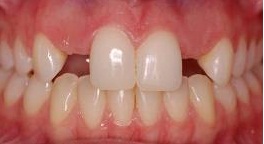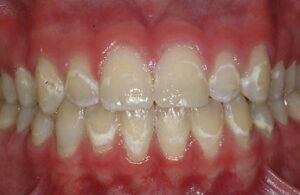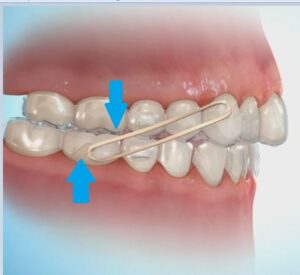August 27th, 2021
The majority of people in the world develop and grow one complete set of baby teeth and one complete set of adult teeth. However, you might be surprised to learn that studies show up to 11% of people are born missing at least one adult tooth. This is called a congenitally missing tooth. The percentage of people with a missing tooth varies among different groups of people, but it is safe to say that you probably know someone that was born missing a tooth.

The missing tooth is often discovered in the first few visits to your dentist. If it is a wisdom tooth, it may not be discovered until later as these teeth start forming well into childhood. When you discover that one of your teeth never formed, there are few options to address it that you might consider.
First, when no adult tooth forms, the baby tooth will often remain well into adulthood because there is no adult tooth growing in to push it out. I have seen many adults well into their 40’s and even 50’s with baby teeth still present because the adult tooth never formed. You may be able to use this tooth for many years, although very few baby teeth will last a lifetime. When the baby tooth eventually fails, the missing adult tooth can be replaced with either a dental implant or a dental bridge.
Another option is to remove the baby tooth prior to orthodontic treatment and close the space for the missing tooth. This is called a substitution treatment and can be a great option for someone who is a good candidate. Being a good candidate is determined by many factors including the location of the missing tooth, the bone health, a patient’s age, and the health of the surrounding teeth. The main advantage of this option is that you don’t have to worry about replacing the missing tooth with some form of a fake tooth in the future. If you were born missing a tooth, we can help you decide what option is the best option in your specific case.
June 29th, 2021
The foods we eat and the beverages we drink can slowly cause staining to the surfaces of our teeth. This type of staining is generally very superficial and can be easily removed by polishing the enamel surface of the tooth. This is one reason why it is important to see your dentist at least every six months for a cleaning.
However, there is another type of staining that is not just on the surface and cannot be removed. This type of stain is caused by poor oral hygiene and is completely avoidable with good brushing and flossing. Having braces on your teeth will not doom you to have stains on your teeth. In fact, the opposite is true. Braces or Invisalign can give you a beautiful smile that you can achieve in no other way. That being said, proper care of your teeth is essential during orthodontic treatment. Teeth that are not cleaned regularly will be begin to accumulate plaque bacteria. Plaque bacteria can slowly leach minerals out of teeth causing light to reflect differently off of the surface of your teeth. This change can give the appearance of a white stain on the surface of the tooth – a portion of the tooth that appears whiter with an irregular border around it. This type of staining is often referred to as a “white spot lesion”. Over time, white spot lesions can progress into cavities if enough mineral is lost from the tooth. The area that loses too much mineral will cave in and create a hole in the tooth, thus the name “cavity”.

If white spot lesions occur, there are products designed to try to restore the lost minerals to the tooth to mask the appearance of the white staining. While these products can help to some degree, they generally cannot restore the tooth to its original condition and some of the stain will remain. When this happens, the only way to eliminate the stain is to cover it up with some type of filling or veneer to mask its appearance. While this is always an option, it is obviously much better to avoid the stain to begin with.
In our office, we use a sealant around the braces to help avoid any staining in patients who struggle with their brushing and flossing. Fluoride rinses have also been shown to be effective in studies to help avoid white spot staining on the teeth. However, nothing can take the place of good oral hygiene with regular brushing and flossing. Maintaining clean teeth during orthodontic treatment will pay dividends for the rest of your life. It is definitely worth the effort.
May 25th, 2021
So you are getting ready to make your first visit to the orthodontist. What will happen at this visit? Will it hurt? Will it take a long time?
Due to the fact that we don’t know what type of orthodontic problems you will have or how many questions you might have about your treatment, we typically schedule one hour for a new patient consultation. Every new patient will meet personally with Dr. Budd and have an opportunity to have all their questions answered. Here is what you can expect:
- The first thing we will do is gather information regarding your medical and dental health history, insurance information (the initial consultation is complimentary but we want to be able to give you an accurate out-of-pocket cost for any treatment we recommend), and a brief description of what you hope to accomplish with your orthodontic treatment. This information can be completed prior to your visit or upon arrival. A parent or guardian must accompany any patient under 18 years old for the initial consultation.
- Photographs will be taken of your face and teeth. These photographs will be reviewed together with Dr. Budd to make it easier to discuss and visualize any recommended treatment. Dr. Budd may also recommend radiographs (X-rays) if there is additional information to be learned that might affect his recommendation for your treatment.
- Dr. Budd will then perform an examination to determine what your treatment options would be given your specific orthodontic needs. He will create a smile design recommendation for you and answer any questions you might have about the recommendations.
- You will receive information regarding the cost of your proposed treatment, any insurance coverage, payment options including payment plans, and available appointment times for starting treatment if treatment is recommended.
Give us a call if we can be of service! We look forward to meeting you!
April 12th, 2021
Most people think of orthodontic treatment in terms of making crooked teeth straight or aligning the teeth. This is an important part of braces or Invisalign and the part of treatment that most patients get very excited about. However, most patients need more than just alignment of the teeth in order to achieve an ideal result and the most esthetic, healthiest smile possible. This is the role that orthodontic elastics or rubber bands play in orthodontic treatment. Elastics correct the bite and braces or Invisalign straighten the teeth. Well-aligned teeth look much better than crooked teeth, but this change alone will leave the teeth not fitting together very well in most cases. Poorly fitting teeth or “bad bites” can contribute to dental decay, periodontal disease, and temporomandibular joint problems over the course of time.


Elastics are the most common bite-corrector used in orthodontic treatment. They can be used to create a similar effect to headgear or other appliances, but are a lot more comfortable and simple to wear. Most patients will need to wear elastics full-time (22 hours/day) to create the desired effect in a timely manner. The elastics are removed and a fresh set of elastics is placed four times per day. (Breakfast, lunch, dinner, and before bedtime.) You simply remove them to eat and put new elastics into your mouth after you are done eating.
Elastics will change the way your bite fits together, which highlights the importance of who you choose to help you with your orthodontic treatment. Elastics worn incorrectly can cause a number of dental problems including tooth loss. Orthodontists are specifically trained in this type of treatment. Only 6% of dentists are actually trained orthodontists, so make sure the doctor helping you with your treatment is a member of the American Association of Orthodontists. Give Budd Orthodontics a call today if we can be of service to you.
Tags: orthodontic treatment, orthodontist, braces, Invisalign, bite problems, elastics, rubber bands, bite correction
Posted in Health benefits of orthodontic treatment, Orthodontist, Braces, Invisalign, Elastics | No Comments











 Website Powered by Sesame 24-7™
Website Powered by Sesame 24-7™